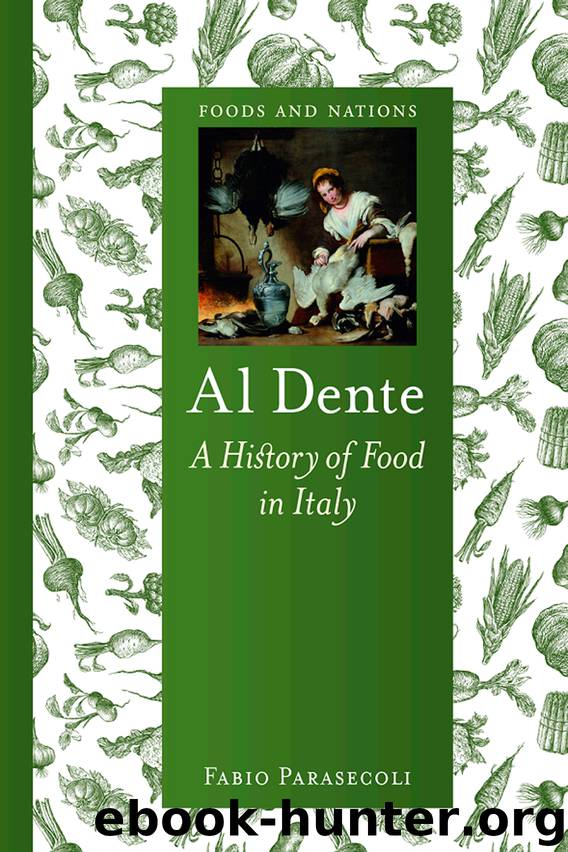Al Dente by Fabio Parasecoli

Author:Fabio Parasecoli [Parasecoli, Fabio]
Language: eng
Format: epub
Publisher: Reaktion Books
Published: 0101-01-01T00:00:00+00:00
Cookbooks and women’s magazines played an important role in educating women of all classes, spreading bourgeois ideals of propriety and thriftiness while making local recipes and ingredients known all over the country. The publishing industry contributed to normalizing the food policies of Fascism and motivating Italians not only to embrace efficiency and modernity, but to cook in more frugal ways. Housewives had to negotiate between the call to reduce waste, eating according to the regime’s patriotic directives, and the need to maintain the family’s health and morale, impressing guests (fare bella figura) even on a tight budget. Fernanda Momigliano’s Vivere bene in tempi difficili (Living Well in Hard Times, 1933) advised readers by imagining an urban family of four living on a modest income. Cookbooks were published that embraced the refusal of meat as a fashion and a symbol of modern consumption, following the establishment of the Italian association of vegetarians in 1905.26 In 1930 Duke Enrico Alliata di Salaparuta published Cucina vegetariana: manuale di gastrosofia naturista (Vegetarian Cuisine: A Manual of Natural Gastrosophy), in which the dietary choices were not dictated by the Fascist call to sobriety, but rather by philosophical choices and refined upper-class overtones. In 1929, the monthly magazine La cucina italiana, printed on thin, foldable paper like a daily, presented itself as ‘a magazine of gastronomy for families and gourmets’, negotiating a middle ground between the interests of upper-class consumers and the needs of middle-class housewives. In 1932 the magazine was sold to the newspaper Giornale d’Italia and became an amplifier for Fascist food-related policies. One of the most popular books of the period was Ada Boni’s Il talismano della felicità (The Talisman for Happiness), first published in 1925, which already in its title promised domestic bliss to all those who cooked following its recipes. Boni’s volume, which is still considered a classic and is often given as a present to newlywed women, went through many reprints and changes over time. After the demise of Fascism, the more patriotic and propagandistic overtones were eliminated to make the new editions of Il talismano acceptable. Ada Boni, a Roman lady who paid great attention to trends and novelties, had already launched the magazine Preziosa in 1915, promoting an interest in practicality and domestic advice for women that resonated in autarchy times. Other female food writers acquired great notoriety in this period. In 1929 Amalia Moretti Foggia della Rovere, famous under her nom de plume Petronilla, started writing for the weekly magazine La domenica del corriere about health and nutrition. One of the first Italian women to earn a university degree (in biology and medicine), she worked as a paediatrician in Milan, garnering a faithful readership when she started her column ‘Tra i fornelli’ (At the Stove). Her personal and refined tone struck a chord among housewives who wanted to maintain propriety even during the hard times of food rationing and autarchy, a situation the author barely acknowledged.
Download
This site does not store any files on its server. We only index and link to content provided by other sites. Please contact the content providers to delete copyright contents if any and email us, we'll remove relevant links or contents immediately.
A Court of Wings and Ruin by Sarah J. Maas(7264)
The Sprouting Book by Ann Wigmore(3409)
Better Homes and Gardens New Cookbook by Better Homes & Gardens(3371)
The Death of the Heart by Elizabeth Bowen(3342)
BraveTart by Stella Parks(3307)
Salt, Fat, Acid, Heat: Mastering the Elements of Good Cooking by Nosrat Samin(2998)
Sauces by James Peterson(2964)
The Bread Bible by Rose Levy Beranbaum(2887)
Classic by Mary Berry(2834)
Kitchen confidential by Anthony Bourdain(2831)
Solo Food by Janneke Vreugdenhil(2823)
Ottolenghi - The Cookbook by Yotam Ottolenghi(2738)
Martha Stewart's Baking Handbook by Martha Stewart(2676)
Betty Crocker's Good and Easy Cook Book by Betty Crocker(2598)
Day by Elie Wiesel(2593)
My Pantry by Alice Waters(2434)
The Plant Paradox by Dr. Steven R. Gundry M.D(2427)
The Kitchen Counter Cooking School by Kathleen Flinn(2396)
Hot Sauce Nation by Denver Nicks(2369)
